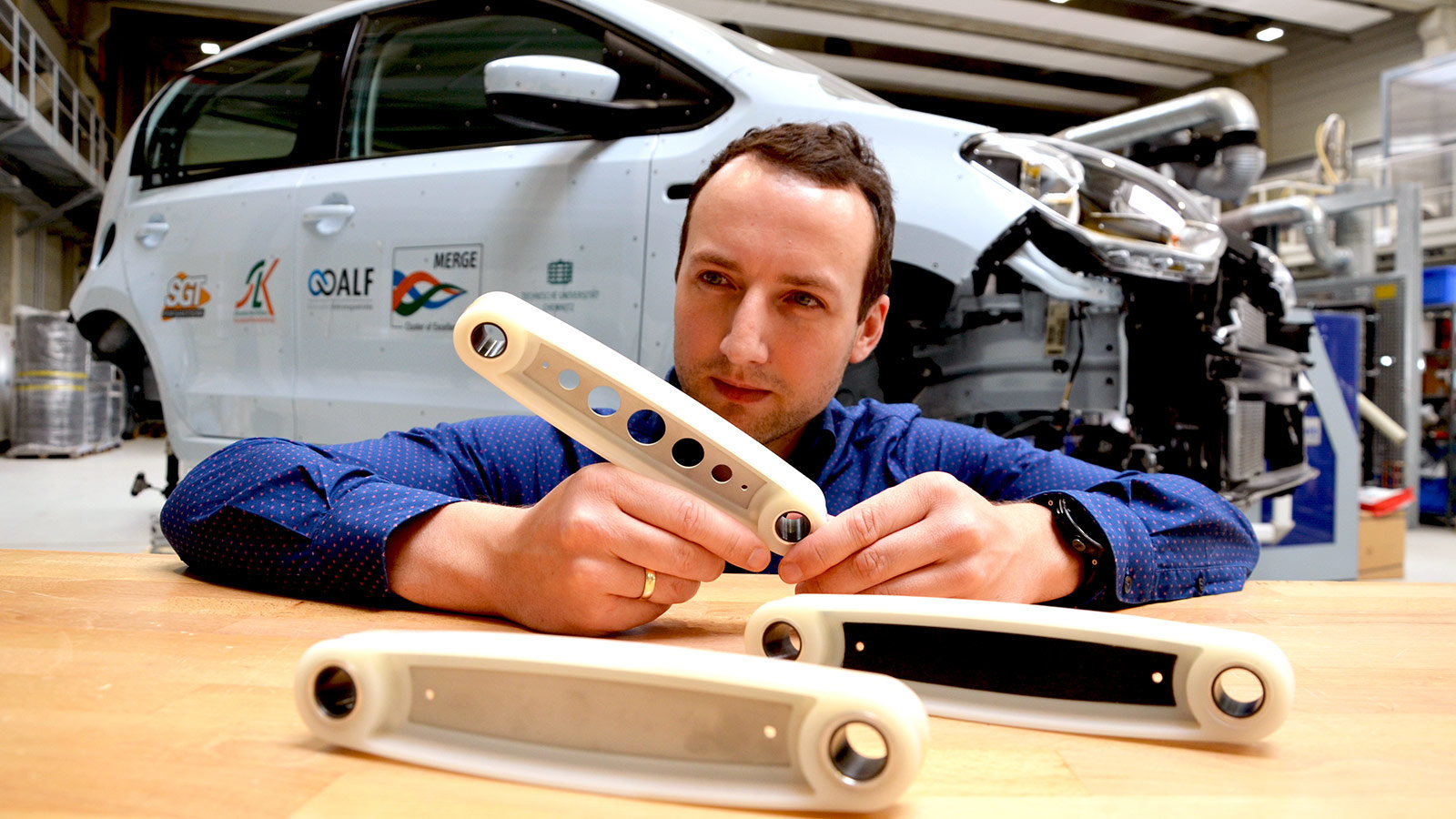Driving a car made easy
Federal Cluster of Excellence MERGE presents new lightweight construction prototypes for automotive industry at the Hannover Fair 2018 from April 23rd till 27th, 2018
-

MERGE employee Tristan Timmel in front of the “MERGE up!” from the Chemnitz Car Concept with coupling struts in three different versions.
The Federal Cluster of Excellence “Technologies for Multifunctional Lightweight Structures” (MERGE) at Chemnitz University of Technology conducts research on the development of hybrid lightweight components via novel technology and material usage. The application of fiber compounds in automotive industry has several benefits. Aside from weight reduction and costs, the fulfillment of climate targets is supported. “Every kilogram saved on a car reduces the fuel consumption and thus CO2 emissions”, explains Prof. Lothar Kroll, CEO of the Federal Cluster of Excellence. Thus, at the Hannover Fair 2018, MERGE will present compounds made of fiber-reinforced plastic that can assist in the total weight reduction of a car.
At the interface of chassis and drive
With highly-efficient and integrated process procedures and according to the motto “One Shot, One Compound”, MERGE researchers developed so-called coupling struts with novel compound structure produced via injection molding technology. The researchers managed to reduce the weight of these car-compounds by 75% while simultaneously reaching a significant reduction of costs and an increase in durability. “The changed structure of this function-integrated interface element enables a targeted transfer of high local stress by means of load-bearing depositors. For this purpose, so-called organo sheets, in other words thermoplastic laminates with continuous fiber-reinforcement, or contoured metal sheets are placed inside the injection molding machine alongside pods as a handling system for the subsequent installation in the vehicle and then coated with plastic”, explains Tristan Timmel, research assistant at the Federal Cluster of Excellence MERGE. What’s special about it: Due to the automatization of the process, the single components of the compound can even in large-scale production be inserted individually depending on their intended use, but don’t have to be assembled as in the previous subsequent assembly steps. This not only saves time but also energy and costs.
The coupling struts are used in the area of the chassis and as torque value support in the area of the drive train. The latter absorbs on-load, meaning during vehicle operation, the so-called torque difference between the drive unit and tires and distributes it into the chassis. “The novel compound structure enables us to specifically absorb oscillation from wheel suspension or the drive train, significantly improving the acoustic in the vehicle’s interior. We can realize this vibration damping through the condition of the different depositors, such as material, orientation of fiber, and thickness of the depositor”, says Timmel. The components are also currently used as prototypes in the “Chemnitz Car Concept” (CCC), a system demonstrator on the platform of a VW up!. The CCC represents MERGE technologies as an electrically driven lightweight vehicle. Interior as well as exterior components – from lightweight components to the drive train – are as reference components redeveloped and exemplarily implemented in the “MERGE up!”.
Same suitability, less weight
The MERGE researchers were also able to significantly reduce the weight while remaining at the same level of suitability of a thermoplastic pressure vessel, primarily used in commercial vehicles, by combining injection molding and wrapping technologies. Thus, capacity, size, and operating pressure of the component were maintained. By reducing the weight from 2,8 kg to 1,3 kg, the researchers managed a weight reduction of more than 50%. They also produced a natural gas rack for vehicles, used to secure gas pressure vessels, made of fiber-reinforced thermoplastic semi-finished parts as pressed component. Compared to the common production procedure, not only 15kg weight could be reduced but also costs decreased, as a simpler assembly demands less total production time.
As the demand for lighter components and lower costs at simultaneous equal suitability and safety in a vehicle is steadily increasing and plays an increasing role in the future of automobile manufacture, the lightweight construction research and technology development conducted at Chemnitz University are fundamental for further developments. The researchers of the Federal Cluster of Excellence MERGE present their current state of research and prototypes of previous developments at the Hannover Fair 2018. From April 23rd till 27th, they present the pressure vessel, the natural gas rack, the coupling struts, as well as newly developed hybrid lightweight components at the joint booth “Forschung für die Zukunft” (Research for the Future), in Hall 02, booth A38.
Background: Key technology lightweight construction in the Federal Cluster of Excellence MERGE
The Federal Cluster of Excellence “Technologies for Multifunctional Lightweight Structures” (MERGE) at Chemnitz University of Technology is the first and only Federal Cluster of Excellence in the field of lightweight construction research. Aim is to merge still separated production technologies of different material groups such as textiles, plastics, and metals and simultaneously equip components and semi-finished parts with sensors and actuators. Thus, the large-scale production of multi-component parts is cheaper and more energy-efficient.
Last year at the Hannover Fair, the Chemnitz researchers presented a load-through system of a vehicle backseat, a component with its weight reduced by over 50% and able to withstand the forces in case of a crash. This was the first structural component designed, technologically implemented as prototype, and further developed for large-scale series production in the Chemnitz Cluster of Excellence.
Homepage of the Federal Cluster of Excellence MERGE: www.tu-chemnitz.de/MERGE
Further information are available from Prof. Lothar Kroll, phone +49 371 531 13910, email merge@tu-chemnitz.de
(Translation: Alissa Hölzel)
Matthias Fejes
16.04.2018





